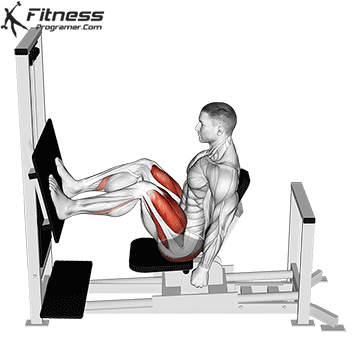Leg Press
The leg press, is a type of strength training exercise. It’s an effective move for strengthening your quadriceps, which are in the front of your upper legs. It is commonly performed using a leg press machine, which typically consists of a seat and a platform to which weight plates can be added.
How To do:
- Adjust the seat position: Sit on the seat with your back against the backrest and your feet resting flat on the platform. Your knees should be bent at a 90-degree angle.
- Adjust the weight: Add weight plates to the machine according to your desired intensity level. Start with a weight that you can comfortably handle and gradually increase it as you progress.
- Foot placement: Position your feet hip-width apart on the platform, with toes pointing forward or slightly outward. Ensure your feet are placed firmly and securely on the platform.
- Preparation: Grip the handles or side supports of the machine for stability. Take a deep breath and brace your core muscles.
- Execution: Push against the platform with your feet and extend your legs, driving the platform away from your body. Keep your back against the seat throughout the movement and avoid locking your knees at the top of the movement.
- Lowering the weight: Slowly bend your knees and lower the weight back down, allowing your knees to reach a 90-degree angle or slightly beyond without letting the weight touch down completely.
- Repeat: Complete the desired number of repetitions, maintaining control and proper form throughout the exercise.
Remember to start with lighter weights and gradually increase the load as you become more comfortable and confident with the exercise.
Leg Press Benefits
The leg press is an effective isolation exercise that primarily targets the quadriceps muscles. Here are some benefits of including leg press in your workout routine:
Provides volume increase in legs: The leg press allows you to use heavy weights, which can promote muscle hypertrophy (growth) in the lower body. If your goal is to add volume to your legs, leg press is one of the best leg exercises that focus solely on the big leg muscles. By progressively increasing the weight over time, you can stimulate muscle growth and develop stronger, more defined legs.
Increases growth hormone and testosterone levels: Studies show that both Leg press and Squat increase testosterone, growth hormone and cortisol levels, but squat exercise increases by 16.7% more than leg press exercise.
Building muscular endurance: Leg presses can also help build muscular endurance in the lower body. Endurance is important for maintaining a consistent pace and resisting fatigue during long-distance runs. As you progressively increase the repetitions or duration of leg press exercises, your leg muscles will adapt and become more resistant to fatigue, enabling you to sustain your running performance for longer periods.
Supports bone density: Resistance exercises like the leg press help promote bone health and increase bone density. Weight training exercises stimulate the bones to adapt and become stronger, which is especially important for preventing age-related conditions like osteoporosis.
Offers joint stability: The leg press exercise involves controlled movement patterns, which can help strengthen the muscles around the knee and hip joints. This can improve joint stability, potentially reducing the risk of injuries or imbalances.
Suitable for various fitness levels: The leg press is a relatively safe exercise that can be adapted to different fitness levels. It can be modified by adjusting the weight, foot placement, or range of motion to suit your individual needs and capabilities.
Finally, the leg press can help increase your speed and ability to accelerate. Moving fast requires your legs to build enough force to push your body forward. The more force you create, the further you move with each step.
Leg Press – Muscles Worked

Leg Press Variations
It’s worth mentioning that the leg press can be performed in different variations, such as single-leg presses or using different foot positions. These variations can provide additional challenges or target specific muscle groups.





